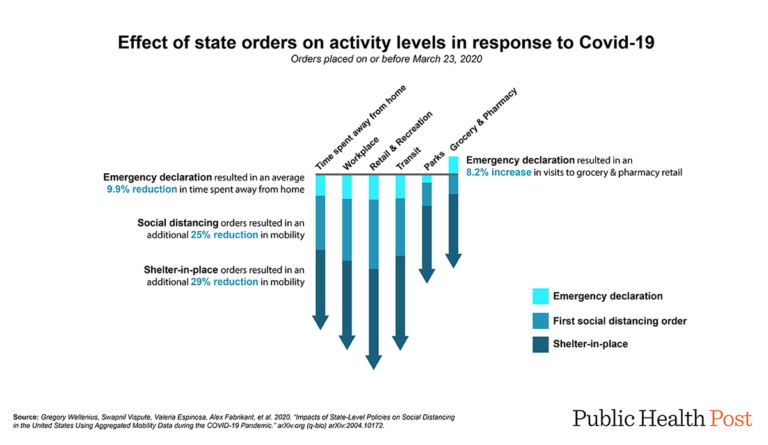Change of State
Analysis of Google location history revealed how effective emergency declaration, social distancing, and shelter-in-place were at influencing behavior.

Read Time: 2 minutes
Published:
Without a consistent national response to the Covid-19 pandemic, states were left to decide which public health interventions to implement and when to begin them. Aiming to promote social distancing, three major state mandates were initiated during March 2020: emergency declaration, followed by social distancing, then shelter-in-place.
Analysis of Google location history revealed how effective each of these orders were at influencing distancing behavior. Overall, each order resulted in more time spent at home and away from public establishments. However, the different orders varied in effectiveness. As seen in the diagram, emergency declaration resulted in an average 10% reduction in time spent away from home, but an 8.2% increase in visits to grocery and pharmacy retailers. Social distancing orders resulted in a larger overall 25% reduction in mobility, shelter-in-place orders an additional 29% reduction.
The study by Gregory Wellenius and colleagues also found that the closure of different types of establishments had varying effects on behavior. The closure of bar and restaurant operations was significantly more effective at reducing mobility than school closures, bans of large gatherings, or closure of non-essential businesses. Combining multiple orders had a greater cumulative effect on behavior change than the sum of any parts.
Social distancing is effective at mitigating the spread of infectious disease, as learned from past pandemics, smaller outbreaks, and targeted distancing for individuals. The resulting change in behavior after state mandates were implemented in response to Covid-19 demonstrates that government orders are effective at promoting social distancing at the population level. Knowing which mandates have the greatest effect on distancing behavior not only informs how we might slow the spread of disease in the early stages of an epidemic, but may also provide foresight into the effect that lifting each order might have as states reopen.
Databyte via Gregory Wellenius, Swapnil Vispute, Valeria Espinosa, Alex Fabrikant, et al. 2020. “Impacts of State-Level Policies on Social Distancing in the United States Using Aggregated Mobility Data during the COVID-19 Pandemic.” Visualization by Tasha McAbee.



